Input interpretation

methylcyclohexane
Chemical names and formulas

formula | C_6H_11CH_3 Hill formula | C_7H_14 name | methylcyclohexane alternate names | cyclohexane, methyl- | cyclohexylmethane | hexahydrotoluene | toluene, hexahydro- mass fractions | C (carbon) 85.6% | H (hydrogen) 14.4%
Lewis structure
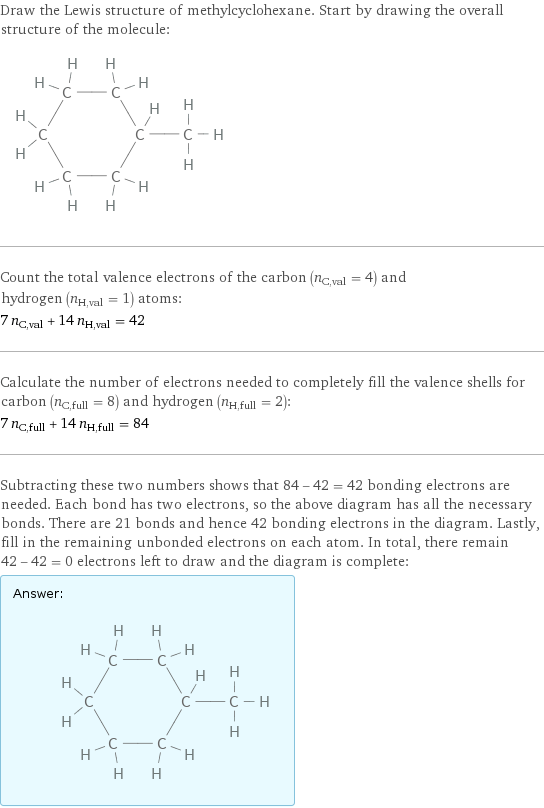
Draw the Lewis structure of methylcyclohexane. Start by drawing the overall structure of the molecule: Count the total valence electrons of the carbon (n_C, val = 4) and hydrogen (n_H, val = 1) atoms: 7 n_C, val + 14 n_H, val = 42 Calculate the number of electrons needed to completely fill the valence shells for carbon (n_C, full = 8) and hydrogen (n_H, full = 2): 7 n_C, full + 14 n_H, full = 84 Subtracting these two numbers shows that 84 - 42 = 42 bonding electrons are needed. Each bond has two electrons, so the above diagram has all the necessary bonds. There are 21 bonds and hence 42 bonding electrons in the diagram. Lastly, fill in the remaining unbonded electrons on each atom. In total, there remain 42 - 42 = 0 electrons left to draw and the diagram is complete: Answer: | |
3D structure

3D structure
Basic properties
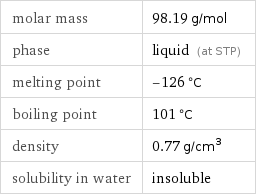
molar mass | 98.19 g/mol phase | liquid (at STP) melting point | -126 °C boiling point | 101 °C density | 0.77 g/cm^3 solubility in water | insoluble
Units

Liquid properties (at STP)
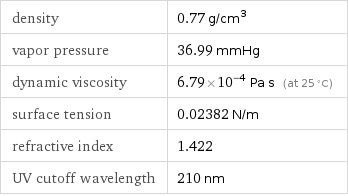
density | 0.77 g/cm^3 vapor pressure | 36.99 mmHg dynamic viscosity | 6.79×10^-4 Pa s (at 25 °C) surface tension | 0.02382 N/m refractive index | 1.422 UV cutoff wavelength | 210 nm
Units

Thermodynamic properties

specific heat capacity c_p | liquid | 1.882 J/(g K) molar heat capacity c_p | liquid | 184.8 J/(mol K) specific heat of formation Δ_fH° | gas | -1.576 kJ/g molar heat of formation Δ_fH° | gas | -154.7 kJ/mol molar heat of vaporization | 31.3 kJ/mol | specific heat of vaporization | 0.319 kJ/g | molar heat of combustion | 4565 kJ/mol | specific heat of combustion | 46.49 kJ/g | molar heat of fusion | 6.75 kJ/mol | specific heat of fusion | 0.0687 kJ/g | thermal conductivity | 0.1081 W/(m K) | critical temperature | 572 K | critical pressure | 3.48 MPa | (at STP)
Chemical identifiers
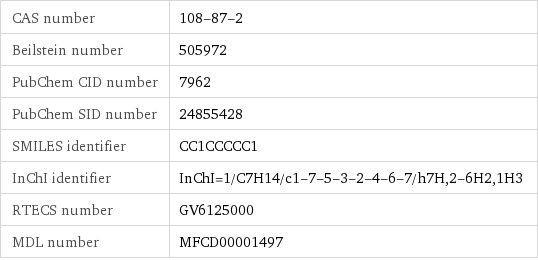
CAS number | 108-87-2 Beilstein number | 505972 PubChem CID number | 7962 PubChem SID number | 24855428 SMILES identifier | CC1CCCCC1 InChI identifier | InChI=1/C7H14/c1-7-5-3-2-4-6-7/h7H, 2-6H2, 1H3 RTECS number | GV6125000 MDL number | MFCD00001497
NFPA label

NFPA label
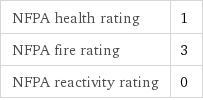
NFPA health rating | 1 NFPA fire rating | 3 NFPA reactivity rating | 0
Safety properties

flash point | -3.889 °C autoignition point | 260 °C lower explosive limit | 1.1% (concentration in air) upper explosive limit | 6.7% (concentration in air)

DOT hazard class | 3 DOT numbers | 2296
Toxicity properties

threshold limit value | 400 ppmv

RTECS classes | primary irritant